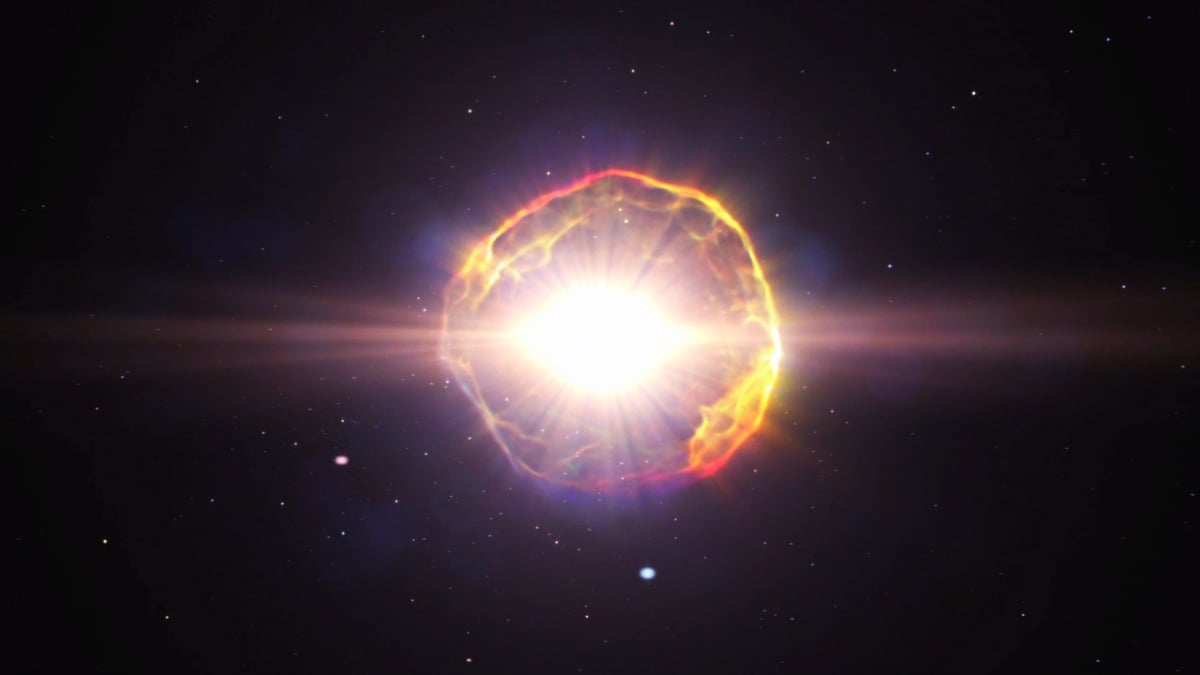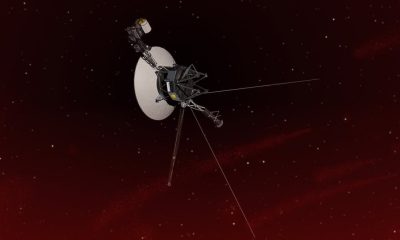Entertainment
The most extreme space explosions and crashes of 2022

Space explosions aren’t the end. They’re often the beginning.
The explosions of massive stars, for example, spread essential elements around the universe. That includes iron, which helps our cells carry blood, and the oxygen we breathe. The violent blasts themselves manufacture heavier elements. You are made of stars, too. And when stars explode, they can form colossal regions of gas and dust, called nebulae, where bounties of new stars can form in the roiling clouds.
In 2022, astronomers detected a number of violent explosions and crashes in space — including one intentionally created by humans. Below are the particularly momentous events, in our solar system and beyond.
A massive, exploding star

An artist’s conception of a gamma-ray burst from an exploding star.
Credit: NASA / ESA / M. Kornmesser
On Oct. 9, astronomers observed an extraordinarily colossal boom. NASA’s Swift Observatory, which is specifically designed to spot the most powerful known explosions in the universe today — called gamma-ray bursts — detected an extremely strong such burst. Something wildly potent must produce these jets of energy that travel through space, and scientists say they’re caused by the collapse and explosion of enormous stars, events called supernovae.
For a star to go supernova, it must be quite massive — at least eight times the size of the sun. But for a supernova to produce the strongest type of gamma-ray burst, the star must be some 30 to 40 times the size of the sun. This new powerful detection, so rare that we’ll likely only observe something of this magnitude around once a decade, came from such a mighty star.
“It’s a very unique event,” Yvette Cendes, an astronomer and postdoctoral fellow at the Harvard-Smithsonian Center for Astrophysics, told Mashable.
Importantly, you need not worry. This terrific explosion happened in a galaxy 2 billion light-years away. At such a distance, its energy, which has been traveling and spreading through space for eons, poses no danger to us. But we can easily, with satellites, detect it.
“It’s the equivalent of getting front row seats at a fireworks show,” Cendes explained.
You can read the full story on Mashable.
Huge, mysterious blast detected in deep space

An artist’s conception of the aftermath of a kilonova blast in deep space.
Credit: X-ray: NASA / CXC / Northwestern Univ. / A. Hajela et al. // Illustration: NASA / CXC / M.Weiss
Scientists recently observed a giant blast some 130 million light-years from Earth. Previously, they detected a colossal collision here from a well-known merger between two neutron stars — collapsed stars that are perhaps the densest objects in the universe. But that dramatic event, which produced a potent stream of energy, had began to fade. Around three and a half years later, something else, something new, has created another curious blast or release of energy.
“There’s something else happening now,” Edo Berger, a professor of astronomy at Harvard University, and one of the scientists who detected this new cosmic event, told Mashable.
The burst of energy, picked up by NASA’s Chandra X-ray Observatory (which detects emissions from extremely hot places in the universe), was intense. Astronomers liken it to the sonic boom made when a speeding plane breaks the sound barrier.
In new research published in The Astrophysical Journal Letters, astronomers propose two possible scenarios that might explain the event, neither of which has ever been observed before, explained Aprajita Hajela, an astronomer who led the research. Hajela is a PhD student in the Department of Physics and Astronomy at Northwestern University.
-
A “kilonova glow”: A what? In the explanation currently considered likeliest, when two neutron stars (bodies so incredibly dense that a teaspoon of neutron star weighs around a whopping 1 billion tons) collided, they created an extremely bright blast, called a kilonova. Kilonovas may be of great importance to the universe, and our lives: Astronomers suspect important elements and metals are forged in these blasts, like gold and platinum. “It is one of the proposed predominant sites for the heavier elements in the universe,” explained Hajela.
But after this immense kilonova explosion, astronomers propose that debris expanded out into space, generating a shock wave, or blast. The blast heated up anything around like gases or stardust. This is the kilonova glow or afterglow we can detect from millions of light-years away.
-
Black hole: Another possibility is the dramatic neutron star merger created a black hole — an “object with a gravitational pull so strong that nothing, not even light, can escape it,” explains NASA — and now matter from the collision is falling into the black hole. When debris falls in, it releases bounties of energy as it spirals around the powerful, dark object. This could be the source of this newly detected energy from distant space.
You can read the full story on Mashable.
Amazed scientists watched a giant star explode for the first time

The exploded star Tycho, called the Tycho Supernova. (It’s not the star recently observed exploding, but a past supernova event.)
Credit: NASA / CXC / RIKEN And GSFC / T. Sato Et Al. / Optical: DSS
Until recently, astronomers had never directly witnessed the explosion of a massive, aging star. But in 2020, astronomers atop a mountain in Maui used a powerful telescope to detect an unusually active red supergiant, much more distant than Betelgeuse (at some 120 million light-years away). They watched it closely for 130 days, giving themselves an invaluable view of the grand finale. The resulting stellar explosion is called “supernova 2020tlf.”
“We actually saw the star violently erupt,” Wynn Jacobson-Galán, an astronomer at the University of California, Berkeley who led the research, told Mashable. “It’s been something we had wanted to find.”
The research was published this year in The Astrophysical Journal.
The explosion of this star happened well beyond our Milky Way in the galaxy NGC 5731, so there’s no “close-up” footage. (Any stars well beyond our galaxy usually appear as dots seen through our telescopes.) But the astronomers, sensing the explosion was imminent, employed specialized imaging equipment at the W.M. Keck Observatory, atop the lofty Mauna Kea in Hawai’i, to observe the climatic “powerful flash” and intense release of energy.
The blast was conspicuous, even in a distant galaxy filled with luminous stars. “It takes just one supernova to outshine all the other stars in the galaxy,” explained Jacobson-Galán.
You can read the full story on Mashable.
Boom! NASA slammed into an asteroid and filmed the crash

The rocky asteroid Dimorphos.
Credit: NASA / JHUAPL
NASA’s mission to move an asteroid was a great success.
Called the Double Asteroid Redirection Test, or DART, the endeavor was humanity’s first-ever attempt to purposefully nudge a cosmic object. The rocky target, Dimorphos, is not a threat to Earth, but the mission was an experiment to see how civilization could alter the path of a menacing asteroid, should one ever be on a collision course with our planet.
The aim wasn’t to destroy Dimorphos, which at time of impact was some 6.8 million miles from Earth. Rather, the intention was to just smack the stadium-sized asteroid with a spacecraft the size of a vending machine. Scientists slightly nudged the asteroid, ultimately demonstrating proof of the ability to alter an asteroid’s trajectory.
The impact, which blasted some 2 million tons of rock into space, created a tail tens of thousands of miles long. Critically, the impact significantly slowed Dimorphos’ orbit around its parent asteroid, Didymos, proving that the experiment worked.
“What we can learn from the DART mission is all part of […] NASA’s overarching work to understand asteroids and other small bodies in our Solar System,” Tom Statler, the program scientist for DART at NASA, said in a statement. “Impacting the asteroid was just the start. Now we use the observations to study what these bodies are made of and how they were formed – as well as how to defend our planet should there ever be an asteroid headed our way.”
You can read the full story on Mashable.
A rocket slammed into the moon. NASA got a picture.

A rocket booster impacted the moon on March 4, leaving a crater on the lunar surface.
Credit: NASA / Goddard / Arizona State University
The moon has a strange, new crater. But this one’s not natural.
NASA’s Lunar Reconnaissance Orbiter, which had began mapping the moon in 2009, spotted the impact site of a recent rocket crash on the far side of the moon, which occurred in early March. The space agency published imagery of the explosive impact in June which actually resulted in a double crater: a 19.5-yard crater overlapping with a 17.5-yard crater.
Astronomers expected a wayward rocket booster to slam into the moon, making it the first known time that space debris unintentionally impacted our natural satellite. What NASA didn’t expect, however, was a double crater.
“The double crater was unexpected and may indicate that the rocket body had large masses at each end,” NASA wrote in a description of the image. “Typically a spent rocket has mass concentrated at the motor end; the rest of the rocket stage mainly consists of an empty fuel tank. Since the origin of the rocket body remains uncertain, the double nature of the crater may indicate its identity.”
You can read the full story on Mashable.
A colossal meteorite struck Mars. Then NASA made an even bigger discovery.

A large crater on Mars created by a meteoroid impact.
Credit: NASA / JPL-Caltech / University of Arizona
NASA’s Mars Reconnaissance Orbiter, which has zipped around the red desert planet for a decade and a half, snapped a stunning Martian image this year: It’s of a new crater nearly 500 feet across and some 70 feet deep.
“It’s unprecedented to find a fresh impact of this size,” Ingrid Daubar of Brown University, who leads NASA InSight’s Impact Science Working Group, said in a statement. “It’s an exciting moment in geologic history, and we got to witness it.”
NASA’s geologic sleuth InSight lander, which detects Marsquakes, picked up the event in late 2021. Then, the 2022 image revealed valuable resources hidden in the Martian subsurface. As Mashable’s Elisha Sauers reported:
But what’s thrilled scientists perhaps as much as or more than the recorded seismic activity is what the meteor uncovered when it slammed into Mars — huge, boulder-size chunks of ice blasted out of the crater. Up until now, underground ice hadn’t been found in this region, the warmest part of the planet.
“This is really an exciting result,” said Lori Glaze, NASA’s director of planetary science, during a news conference. “We know, of course, that there’s water ice near the poles on Mars. But in planning for future human exploration of Mars, we’d want to land the astronauts as near to the equator as possible, and having access to ice at these lower latitudes, that ice can be converted into water, oxygen, or hydrogen. That could be really useful.”
You can read the full story on Mashable.
Stayed tuned for more momentous space explosions next year. And the year after. And, well, you get the idea.
-

 Business7 days ago
Business7 days agoUnitedHealth says Change hackers stole health data on ‘substantial proportion of people in America’
-

 Business6 days ago
Business6 days agoTesla’s new growth plan is centered around mysterious cheaper models
-

 Business5 days ago
Business5 days agoXaira, an AI drug discovery startup, launches with a massive $1B, says it’s ‘ready’ to start developing drugs
-

 Business5 days ago
Business5 days agoUK probes Amazon and Microsoft over AI partnerships with Mistral, Anthropic, and Inflection
-

 Entertainment3 days ago
Entertainment3 days agoSummer Movie Preview: From ‘Alien’ and ‘Furiosa’ to ‘Deadpool and Wolverine’
-

 Business6 days ago
Business6 days agoTwo widow founders launch DayNew, a social platform for people dealing with grief and trauma
-

 Entertainment6 days ago
Entertainment6 days agoTesla’s in trouble. Is Elon Musk the problem?
-

 Business4 days ago
Business4 days agoPetlibro’s new smart refrigerated wet food feeder is what your cat deserves




























